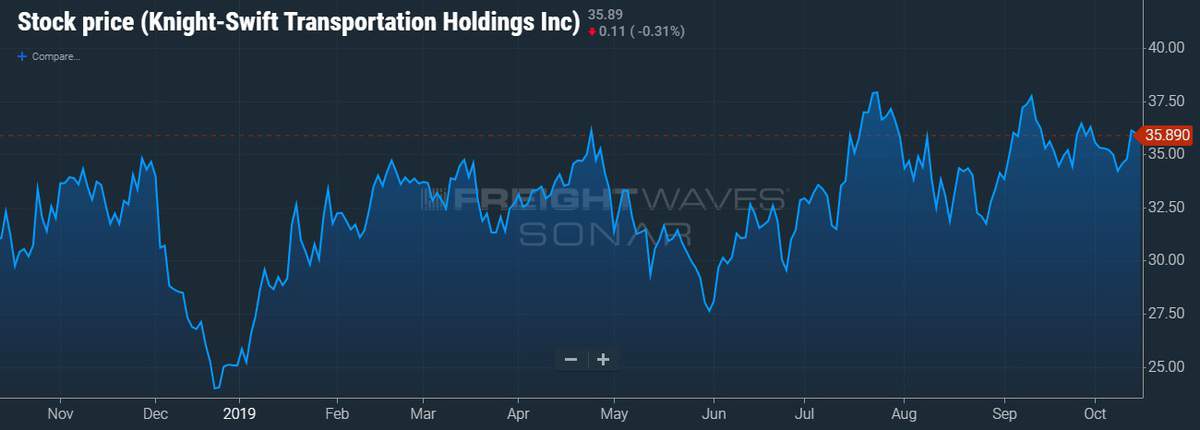In a pre-market open, October 15 press release, Knight-Swift Transportation Holdings, Inc. (NYSE: KNX) announced that it wouldn’t be able to achieve its previously issued earnings guidance for both the third and fourth quarters of 2019.
Knight-Swift said that it now expects adjusted earnings per share (EPS) in the range of $0.47 to $0.48 in the third quarter of 2019 (prior guidance called for $0.54 to $0.57) and $0.62 to $0.65 in adjusted EPS in the fourth quarter of 2019 (prior guidance was $0.73 to $0.77). Additionally, the company issued initial first quarter 2020 guidance of $0.42 to $0.46.
This may not come as much of a surprise to market onlookers. Equity analysts have been lowering estimates over the last couple of weeks heading into earnings season. In Knight-Swift’s case, the current consensus estimates (third quarter is $0.53 and fourth quarter is $0.71) sit below management’s prior guidance ranges, signaling that the market wasn’t believing the company could achieve those levels.
The company’s initial guidance for first quarter 2020 brackets the current consensus estimate of $0.45.
North America’s largest truckload (TL) transportation company cited increased competition in the intermodal market, which is driving lower volumes and revenue per load, and “greater than expected pressure on freight rates” due to excess TL capacity as reasons for the revisions. The press release said that these factors resulted in lower revenue. Lower revenue combined with the cost of exiting an underperforming dedicated contract drove operating income down in the period.
Intermodal traffic on the rails declined 5.8% year-over-year in the third quarter. Excess TL capacity is keeping spot market rates depressed, narrowing the traditional gap between the cost for truck and rail service, resulting in diminished intermodal volumes. Additionally, some analysts believe that the intermodal marketing companies have been attempting to gain market share as a means of stemming industry-wide intermodal demand erosion and propping up their container returns. If so, this likely presents a headwind to intermodal pricing. This was evident in the September Cass Intermodal Price Index, which appears to be moderating from a sustained period of year-over-year increases, up only 0.1% in September.
This estimate reduction was not only expected by the market, but applauded by some as the catalyst needed to get investors engaged in the stock again. In a note to clients this morning titled, “Second Derivative’ Fans Unite as KNX Cuts Guide Again,” Morgan Stanley analyst Ravi Shanker explained that while the guidance cut from Knight-Swift was larger than he expected, it places the company closer to trough earnings, which he believes will “re-rate” the valuation multiple and stock price higher. Shanker also referenced the company’s second quarter earnings cut that prompted an approximately 20% run in the stock, which he believes was triggered by investors searching for a “cyclical bottom” in the name.
Shanker continued, “while the pursuit of bottoming earnings can be long, tricky and frustrating, we remind investors that cyclical earnings troughs deserve peak multiples.” He believes that this rationale holds greater weight if Knight-Swift’s primary reason for the earnings reduction was truly related to intermodal (9% of Knight Swift’s revenue in second quarter 2019, 4% of operating income) and has less to do with the company’s core TL business.
In an October 11 investor note upgrading his rating on Knight-Swift to “buy,” equity analyst Thomas Wadewitz provided a similar sentiment.
“For KNX we believe a reduction in EPS expectations could actually provide a favorable backdrop for the stock,” said Wadewitz. He went on to say that he believes 2020 will be the low point in earnings for the carrier in this TL cycle and that history suggests a peak valuation multiple is appropriate. The thought is that with earnings expectations washed out and capacity being purged from the market, investors are likely to become more constructive on the TLs.
Wadewitz said that he expects continued softness in the spot market to weigh on contractual pricing in 2020, but believes that the expectations for negative earnings revisions are already priced into the stock. His contention is that future supply/demand dynamics for the TLs are more important to investor sentiment and that the industry appears to be on the path to right-sizing capacity. He is calling for “freight to stabilize and for spot market pricing to inflect positively by mid-2020.” He believes that these factors support the peak valuation multiple.
From the Knight-Swift press release, “We continue to expect a seasonal improvement in demand during the fourth quarter of 2019, however, less robust than originally projected. We believe the rationalization of capacity has accelerated and should lead to a more favorable freight environment in the second half of 2020. Our adjusted EPS ranges are based on the current freight market, recent trends, and the current beliefs, assumptions, and expectations of management.”
“Capacity rationalization” is expected as Class 8 truck orders have declined materially. As TL market fundamentals have weakened significantly in 2019, many fleets have been purging capacity. New orders are running at roughly 150,000 units on a seasonally adjusted annual rate, compared to standard replacement demand, which is estimated to be 250,000 to 300,000 units on an annual basis. Further, capacity is expected to be trimmed as regulatory requirements increase throughout the industry.
Shares of KNX are flat in today’s trading.









Chris Harper
As a driver manager for Knight I am ashamed of this merger and have lost respect for the CEO.
Robert Gaylord
Swift us the worst of the worst trucking company ever and now it’s stuck on the bottom of knights shoe like dig shit. Knight was crappy enough on its own but now it really has weakened itself by purchasing Swift. What a joke